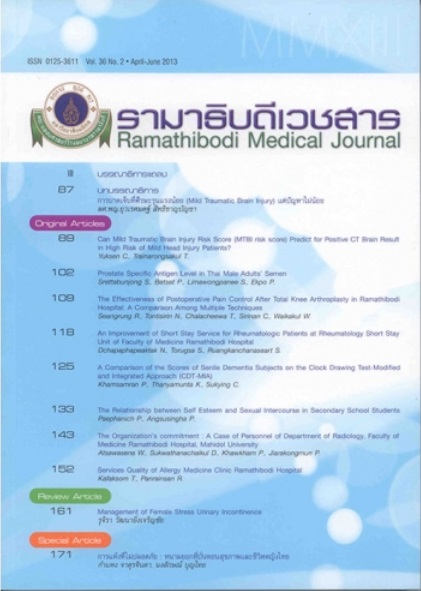The Effectiveness of Postoperative Pain Control After Total Knee Arthroplasty in Ramathibodi Hospital: A Comparison Among Multiple Techniques
Keywords:
Total knee arthroplasty, Postoperative pain control, The effectivenessAbstract
Background: The pain control after a total knee arthroplasty (TKA) is challenging since most of the patients are elderly, often with multiple comorbidities. This study compared the effectiveness of postoperative pain control after TKA among multiple techniques.
Method: A retrospective observational study was conducted involving patients who underwent TKA and had postoperative pain management by Acute Pain Service team in Ramathibodi hospital during January and December 2010. Patients received one of four techniques including continuous femoral nerve analgesia (CFNA), intravenous patient-controlled analgesis (PCA), spinal morphine combined with as needed intravenous tramadol (SM-T), or CFNA combined with PCA (CF-PCA). The effectiveness of pain relief was quantified using numerical rating scale (NRS), the incidence of mild pain (NRS < 4), side effects and patient's satisfaction in 24 and 48 hour after the operation.
Results: One hundred and ninety-one patients (26M: 165F), age 69 8 years old, were enrolled in this study. SM-T group used additional tramadol more than others. CFNA and CF-PCA groups had lower NRS in 24 and 48 hours postoperatively [2 (0 - 7), 2 (0 - 5), 2 (0 - 4)] than SM-T [4 (0 - 10), 4.5 (0 - 5)] and PCA groups [4 (0 - 8), 3 (0 - 6)] (P < 0.05). Percentage of mild pain was highest in CFNA and CF-PCA groups. In addition, SM-T had the most incidence of nausea, vomiting and itching in first 24 hours with the lowest patient's satisfaction (P < 0.05).
Conclusion: The femoral nerve analgesia provided better postoperative pain control with fewer side effects when compared to systemic analgesic alone and spinal morphine.
References
Bellemans J, Vandenneucker H, Vanlauwe J. Total knee replacement. Curr Orthop. 2005;19:446-52.
Akeson WH, Amiel D, Abel MF, Garfin SR, Woo SL. Effects of immobilization on joints. Clin Orthop Relat Res. 1987;216:28-37.
Ryu J, Saito S, Yamamoto K, Sano S. Factors influencing the postoperative range of motion in total knee arthroplasty. Bull Hosp Jt Dis. 1993;53:35-40.
Hernigou P, Poignard A, Nogier A. Rehabilitation following total knee arthroplasty. In: Bellemans J, Ries MD, Victor J. editors. Total knee arthroplasty: a guide to get better performance. 1st ed. New York: Springer; 2005:388-92.
Fischer HB, Simanski CJ, Sharp C, et al. A procedure-specific systematic review and consensus recommendations for postoperative analgesia following total knee arthroplasty. Anaesthesia. 2008;63(10):1105-23. doi:10.1111/j.1365-2044.2008.05565.x.
Hurley RW, Cohen SP. Wu CP. Acute Pain in Adults. In: Fishman SM, Ballatyne JC, Rathmell JP, editors. Bomica's Management of Pain. 4th ed. Baltimore: William & Wilkins; 2010:699-723.
Shoji H, Solomonow M, Yoshino S, D'Ambrosia R, Dabezies E. Factors affecting postoperative flexion in total knee arthroplasty. Orthopedics. 1990;13(6):643-9.
Salmon P, Hall GM, Peerbhoy D, Shenkin A, Parker C. Recovery from hip and knee arthroplasty: Patients' perspective on pain, function, quality of life, and well-being up to 6 months postoperatively. Arch Phys Med Rehabil. 2001;82(3):360-6.
Busch CA, Shore BJ, Bhandari R, et al. Efficacy of periarticular multimodal drug injection in total knee arthroplasty. A randomized trial. J Bone Joint Surg Am. 2006;88(5):959-63.
Brander VA, Stulberg SD, Adams AD, et al. Predicting total knee replacement pain: a prospective, observational study. Clin Orthop Relat Res. 2003;(416):27-36.
Hebl JR, Kopp SL, Ali MH, et al. A comprehensive anesthesia protocol that emphasizes peripheral nerve blockade for total knee and total hip arthroplasty. J Bone Joint Surg Am. 2005;87(Suppl 2):63-70.
Horlocker TT, Kopp SL, Pagnano MW, Hebl JR. Analgesia for total hip and knee arthroplasty: a multimodal pathway featuring peripheral nerve block. J Am Acad Orthop Surg. 2006;14(3):126-35.
White PF. The changing role of non-opioid analgesic techniques in the management of postoperative pain. Anesth Analg. 2005;101(5 Suppl):S5-22.
Edwards ND, Wright EM. Continuous low-dose 3-in-1 nerve blockade for postoperative pain relief after total knee replacement. Anesth Analg. 1992;75(2):265-7.
Serpell MG, Millar FA, Thomson MF. Comparison of lumbar plexus block versus conventional opioid analgesia after total knee replacement. Anaesthesia. 1991;46(4):275-7.
Singelyn FJ, Deyaert M, Joris D, Pendeville E, Gouverneur JM.Singelyn FJ. Effects of intravenous patient-controlled analgesia with morphine, continuous epidural analgesia, and continuous three-in-one block on postoperative pain and knee rehabilitation after unilateral total knee arthroplasty. Anesth Analg. 1998;87(1):88-92.
Capdevila X, Barthelet Y, Biboulet P, Ryckwaert Y, Rubenovitch J, d'Athis F. Effects of perioperative analgesic technique on the surgical outcome and duration of rehabilitation after major knee surgery. Anesthesiology. 1999;91(1):8-15.
Chelly JE, Greger J, Gebhard R, et al. Continuous femoral blocks improve recovery and outcome of patients undergoing total knee arthroplasty. J Arthroplasty. 2001;16(4):436-45.
Singelyn FJ, Gouverneur JM. Extended "three-in-one" block after total knee arthroplasty: continuous versus patient-controlled techniques. Anesth Analg. 2000;91(1):176-80.
Allen HW, Liu SS, Ware PD, Nairn CS, Owens BD. Peripheral nerve blocks improve analgesia after total knee replacement surgery. Anesth Analg. 1998;87(1):93-7.
Tarkkila P, Tuominen M, Huhtala J, Lindgren L. Comparison of intrathecal morphine and continuous femoral 3-in-1 block for pain after major knee surgery under spinal anaesthesia. Eur J Anaesthesiol. 1998;15(1):6-9.
Sites BD, Beach M, Gallagher JD, Jarrett RA, Sparks MB, Lundberg CJ. A single injection ultrasound-assisted femoral nerve block provides side effect-sparing analgesia when compared with intrathecal morphine in patients undergoing total knee arthroplasty. Anesth Analg. 2004;99(5):1539-43.
Trueblood A, Manning DW. Analgesia following total knee arthroplasty. Curr Opin Orthop. 2007;18(1):76-80. doi:10.1097/BCO.0b013e3280119635.
Barrington MJ, Olive D, Low K, Scott DA, Brittain J, Choong P. Continuous femoral nerve blockade or epidural analgesia after total knee replacement: a prospective randomized controlled trial. Anesth Analg. 2005;101(6):1824-9.
Morin AM, Kratz CD, Eberhart LH, et al. Postoperative analgesia and functional recovery after total-knee replacement: comparison of a continuous posterior lumbar plexus (psoas compartment) block, a continuous femoral nerve block, and the combination of a continuous femoral and sciatic nerve block. Reg Anesth Pain Med. 2005;30(5):434-45.
Bailey PL, Rhondeau S, Schafer PG, et al. Dose-response pharmacology of intrathecal morphine in human volunteers. Anesthesiology. 1993;79(1):49-59.
Cole PJ, Craske DA, Wheatley RG. Efficacy and respiratory effects of low-dose spinal morphine for postoperative analgesia following knee arthroplasty. Br J Anaesth. 2000;85(2):233-7.













